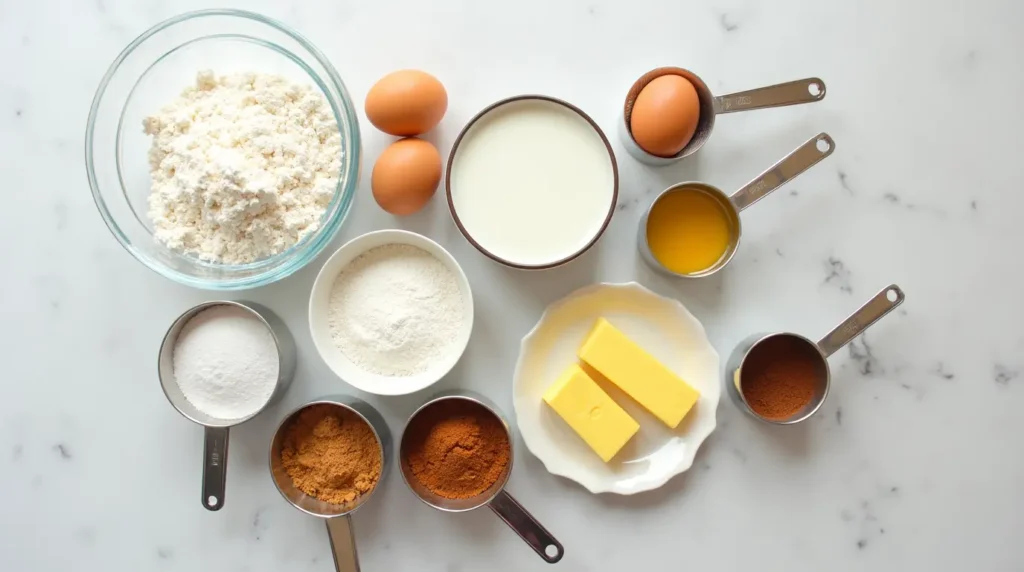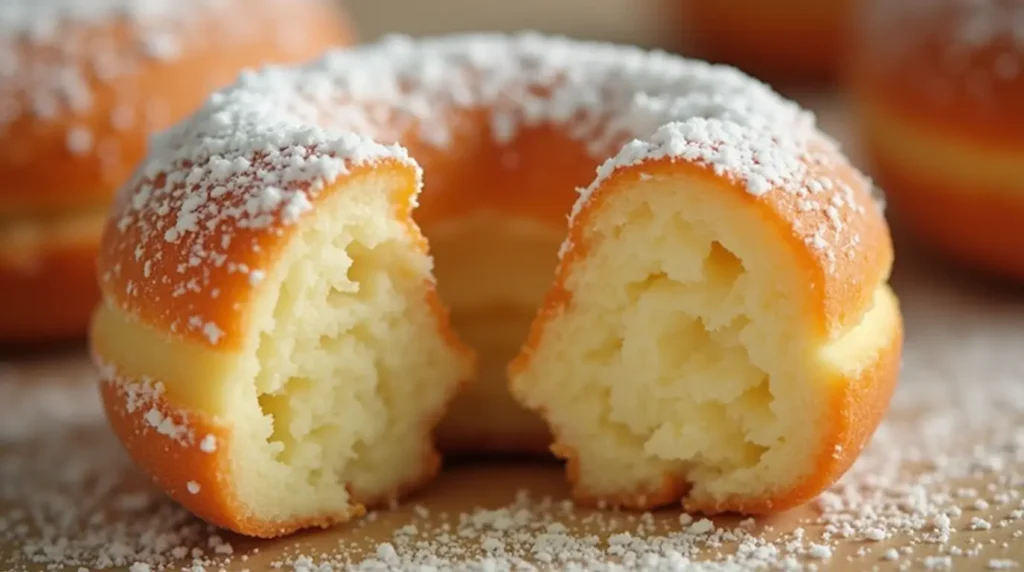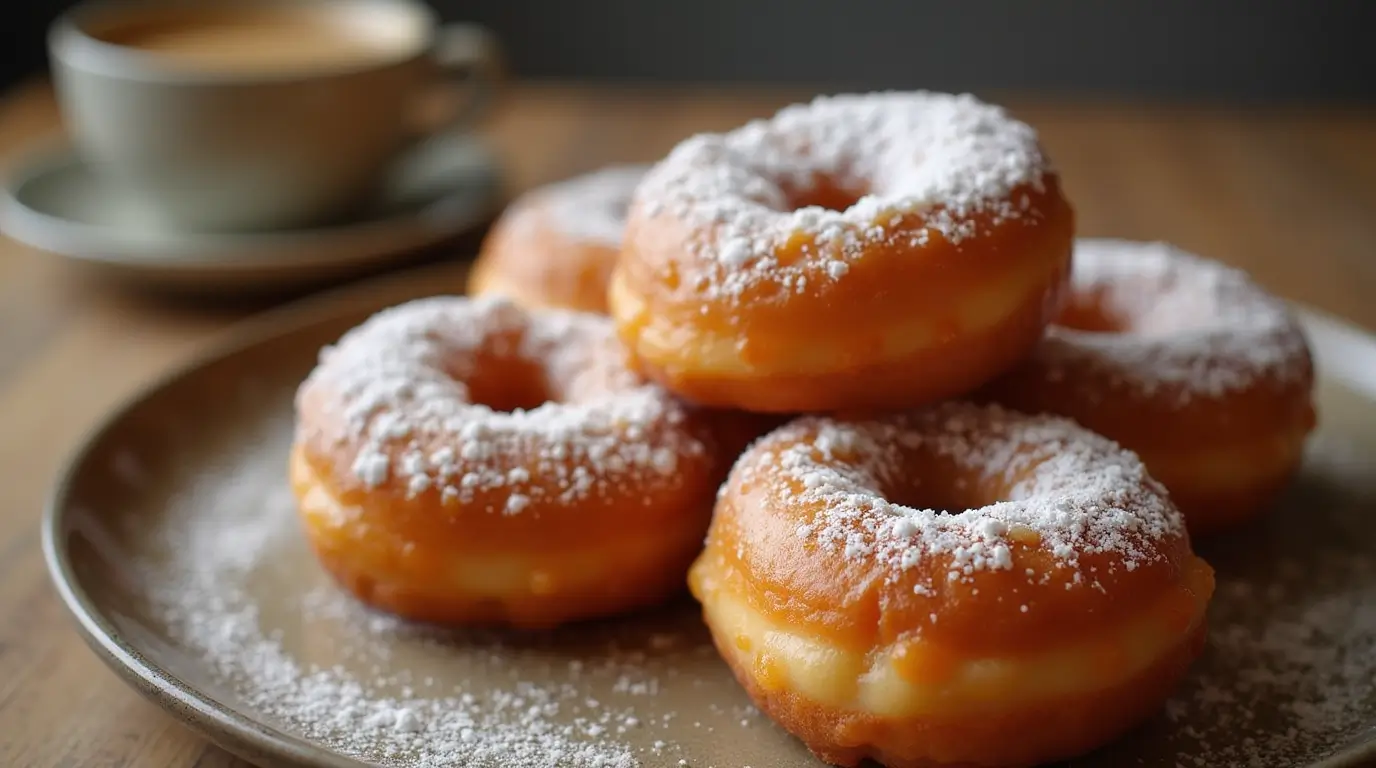Old-fashioned doughnuts are the epitome of comfort food, with their crispy, golden exteriors and soft, airy interiors. This easy-to-make recipe brings you the perfect balance of sweetness and flavor, ideal for breakfast, brunch, or a sweet snack any time of day. With simple ingredients and step-by-step instructions, you can whip up a batch of these delectable doughnuts in no time!
Introduction
There’s something undeniably nostalgic about a fresh batch of old-fashioned doughnuts. Whether you’ve enjoyed them at a local bakery or made them yourself, the crispy edges and soft, pillowy interiors bring a warmth that few other treats can match. This recipe for old-fashioned doughnuts is a tribute to the traditional methods that have stood the test of time. With its slightly tangy flavor from the buttermilk and the irresistible sweetness of a sugar glaze, this treat transports you back to a simpler time when doughnuts were made by hand with love and care.
Old-fashioned doughnuts aren’t just a breakfast item—they can be the centerpiece of any gathering, from holiday brunches to casual get-togethers. They have a rich history, originating in the early days of American baking and evolving over the years into the beloved treat we know today. Making these doughnuts at home is not only incredibly satisfying, but it also allows you to customize them to your liking, whether you prefer them plain, glazed, or dusted with cinnamon sugar. There’s no better way to start the day—or to indulge in an afternoon treat—than with a warm, freshly made doughnut.
Table of Contents
Key Takeaways
- Flavor & Texture: Expect a deliciously crispy exterior and soft, fluffy interior, with a subtle tang from the buttermilk.
- Dietary Considerations: These doughnuts are vegetarian-friendly but not gluten-free. They are perfect for indulging in moderation.
- Versatility: You can customize the glaze or topping to suit your taste. From classic vanilla to chocolate glaze or even a dusting of powdered sugar, the possibilities are endless.
- Ease of Preparation: This recipe is simple enough for beginners, with straightforward steps and minimal ingredients.
Recipe Card
| Prep Time | Cook Time | Total Time | Servings | Calories per Serving |
|---|---|---|---|---|
| 15 minutes | 5-6 minutes | 20 minutes | 12 doughnuts | 250 kcal |
Ingredients
| Ingredient | Quantity | Notes |
|---|---|---|
| All-purpose flour | 2 ¾ cups | Measure accurately for best results |
| Baking powder | 2 ½ tsp | Leavening agent for fluffiness |
| Baking soda | ½ tsp | Balances acidity |
| Salt | ½ tsp | Enhances flavor |
| Ground nutmeg | ½ tsp | Adds warmth and depth |
| Ground cinnamon | 1 tsp | Optional, for extra flavor |
| Granulated sugar | ¼ cup | Sweetens the dough |
| Eggs | 2 large | Bind the dough |
| Buttermilk | ¾ cup | Gives a tangy flavor and softness |
| Vanilla extract | 1 tsp | Adds aromatic flavor |
| Unsalted butter | ¼ cup (½ stick) | Melted, for richness |
| Vegetable oil (for frying) | 3-4 cups | Choose a neutral oil, like canola |

Step-by-Step Recipe Instructions for Old-Fashioned Doughnuts
Step 1: Prepare the Dough
Instructions:
- In a large bowl, whisk together the dry ingredients: flour, baking powder, baking soda, salt, nutmeg, and cinnamon (if using).
- In a separate bowl, whisk together the eggs, sugar, buttermilk, and vanilla extract until well combined.
- Pour the wet mixture into the dry ingredients and stir gently using a wooden spoon or spatula until just combined. Be careful not to overwork the dough to avoid tough doughnuts.
- Add the melted butter and mix until the dough comes together, forming a slightly sticky, yet firm consistency.
Tip: If the dough feels too sticky to handle, lightly flour your hands or work surface to help with rolling and cutting.
Step 2: Roll and Cut the Doughnuts
Instructions:
- Transfer the dough onto a lightly floured surface. Using a rolling pin, gently roll the dough to about ½-inch thickness.
- Using a doughnut cutter or two round cookie cutters (one large and one small), cut out the doughnuts. If you don’t have a doughnut cutter, you can use a round biscuit cutter and a smaller cutter to remove the center.
- Gather any scraps, re-roll them, and cut out additional doughnuts. You should get around 12 doughnuts from the dough.
Tip: For the best results, don’t overwork the dough when re-rolling. This will keep the doughnuts soft and light.
Step 3: Heat the Oil
Instructions:
- Heat vegetable oil to 350°F (175°C) in a deep fryer or large pot. The oil should be deep enough to submerge the doughnuts fully but leave enough room for them to float.
- Use a thermometer to confirm the oil has reached the correct temperature. If it’s too hot, the doughnuts will brown too quickly on the outside while remaining raw on the inside.
Tip: To test the oil, drop a small piece of dough into the oil. If it sizzles and floats to the surface within a few seconds, the oil is ready for frying.
Step 4: Fry the Doughnuts
Instructions:
- Gently lower the doughnuts into the hot oil, one at a time, using a slotted spoon or tongs. Avoid overcrowding the pot, as it may cause the oil temperature to drop.
- Fry each doughnut for about 2 minutes per side, or until golden brown and crisp. Use a slotted spoon to flip them over carefully.
- Once they’re done, remove the doughnuts from the oil and place them on a paper towel-lined plate to drain any excess oil.
Tip: Be mindful of the oil temperature. If it drops too low, the doughnuts will absorb too much oil, becoming greasy.
Step 5: Glaze or Dust the Doughnuts
Instructions:
- As the doughnuts cool slightly, start preparing the glaze. In a small bowl, whisk together powdered sugar, vanilla extract, and a splash of milk. Add more milk if necessary to reach your desired consistency.
- Dip each doughnut into the glaze while it’s still warm, allowing the excess to drip off.
- Alternatively, you can dust the doughnuts with powdered sugar or cinnamon sugar for a simpler touch.
Tip: For a thicker glaze, reduce the amount of milk in the glaze mixture. If you prefer a shiny, smooth finish, dunk the doughnuts immediately after frying.
Notes
- Customization: Feel free to experiment with different flavors for the glaze, such as adding cocoa powder for chocolate glaze or citrus zest for a bright, refreshing touch.
- Frying Tip: If you prefer a lighter, less greasy doughnut, consider frying it in smaller batches to maintain the ideal oil temperature.
- Storage: Store leftover doughnuts in an airtight container at room temperature for up to 2 days, or freeze them for up to a month. Warm them in the oven for a few minutes to restore their crispness.
Nutrition Information
| Nutrient | Amount per Serving |
|---|---|
| Calories | 250 kcal |
| Total Fat | 14g |
| Saturated Fat | 6g |
| Cholesterol | 35mg |
| Sodium | 140mg |
| Total Carbohydrates | 30g |
| Dietary Fiber | 1g |
| Sugars | 14g |
| Protein | 3g |
Tools and Equipment Needed
| Equipment | Purpose |
|---|---|
| Mixing bowls | For combining ingredients |
| Whisk | For mixing wet ingredients |
| Rolling pin | For rolling out the dough |
| Doughnut cutter | For cutting doughnuts into shape |
| Deep fryer or large pot | For frying the doughnuts |
| Slotted spoon or tongs | For safely lowering and removing doughnuts from the oil |
| Thermometer | For monitoring oil temperature |
| Paper towels | For draining excess oil |
| Small bowl | For preparing the glaze |
The History of the Recipe
Old-fashioned doughnuts have a rich history dating back to the early 19th century. While it is difficult to pinpoint an exact origin, it is believed that doughnuts were first introduced to America by Dutch settlers in the 1600s, who brought with them recipes for fried cakes. The classic round shape with a hole in the center was likely introduced in the 19th century to allow the doughnuts to cook more evenly. Old-fashioned doughnuts, in particular, became popular in the early 1900s when they were served at local bakeries and cafes, offering a simple yet delicious treat. Their appeal grew due to their perfect balance of texture—crisp on the outside, fluffy on the inside—and the sweet flavors of buttermilk and vanilla.
Over time, doughnuts evolved with the advent of modern equipment and technology, but the old-fashioned variety remained a beloved favorite. The recipe has been passed down through generations, and today, old-fashioned doughnuts are enjoyed by people of all ages. Their cultural significance continues, as they are often a nostalgic reminder of simpler times, making them a popular choice for breakfast, brunch, or as a sweet snack during the day. The doughnut’s legacy lives on in its ability to adapt while maintaining that timeless flavor and texture.

Common Mistakes to Avoid
When preparing old-fashioned doughnuts, there are a few common mistakes that can affect the final result. One of the biggest pitfalls is overworking the dough. While it’s tempting to knead the dough for longer to ensure it’s fully combined, over-kneading can lead to tough doughnuts. Instead, mix the ingredients until just combined for a lighter texture. Another common mistake is the incorrect oil temperature. If the oil is too hot, the doughnuts will brown too quickly on the outside while remaining raw on the inside. Conversely, if the oil is too cool, the doughnuts will absorb too much oil and become greasy. Using a thermometer to maintain the oil at 350°F (175°C) will help achieve that perfect golden brown exterior.
Finally, imprecise ingredient measurements can lead to doughnuts that are too dense or too sticky. Always use measuring cups and spoons for accuracy, and be sure to measure the flour correctly by spooning it into the cup and leveling it off with a knife. If you pack the flour into the measuring cup, you may end up with too much flour, which can affect the texture. Being mindful of these details will help ensure a successful batch of doughnuts every time.
Why You’ll Love This Recipe
Flavor Profile:
Old-fashioned doughnuts are an irresistible combination of sweetness and subtle tang, thanks to the buttermilk. The dough has a warm, comforting flavor with hints of cinnamon and nutmeg, making each bite an experience of nostalgia and satisfaction. When paired with a glossy glaze or a dusting of powdered sugar, the doughnuts become even more indulgent.
Ease of Preparation:
This recipe is incredibly simple and perfect for beginners. With just a handful of ingredients and straightforward steps, you can create fresh, homemade doughnuts without any specialized equipment. The process is also quick, taking just under 30 minutes from start to finish.
Versatility:
Old-fashioned doughnuts are perfect for any occasion. You can enjoy them as a breakfast treat, serve them at a brunch gathering, or pair them with coffee for a mid-afternoon snack. They are also highly customizable—add a variety of glazes, toppings, or spices to suit your taste. You can even try creating seasonal variations, like pumpkin spice for autumn or citrus zest for a summer twist.
Key Ingredients and Substitutions
The key ingredients in this old-fashioned doughnut recipe include all-purpose flour, baking powder, baking soda, salt, nutmeg, cinnamon, sugar, eggs, buttermilk, and unsalted butter. Each of these ingredients plays an essential role in achieving the perfect doughnut texture and flavor. For example, the buttermilk provides tanginess, helping to balance the sweetness of the doughnut and contribute to its soft, tender crumb. The combination of baking powder and baking soda ensures the doughnuts rise properly, while the butter adds richness.
If you have dietary restrictions or need to make substitutions, there are several options available. For a dairy-free version, you can replace the buttermilk with plant-based milk like almond or soy milk, and use a dairy-free butter alternative. For those with egg allergies, you can use a flax egg or an egg replacement to maintain the texture of the doughnuts. If you’re looking for a healthier alternative, you can substitute whole wheat flour for the all-purpose flour, though the texture will be slightly denser.
Culinary Magic: The Pleasure of Making This Recipe
There’s something magical about creating doughnuts from scratch. The process of mixing the ingredients, rolling out the dough, and watching the doughnuts fry to golden perfection is both satisfying and rewarding. The aroma of fresh doughnuts filling your kitchen is enough to make anyone’s mouth water. As you bite into your homemade creation, you’ll experience the delightful contrast between the crisp exterior and the soft, fluffy interior. It’s a simple joy that’s hard to beat.
Troubleshooting Common Issues
Problem: Doughnuts are too greasy.
Solution: Make sure the oil is at the right temperature (350°F/175°C) before frying. If the oil is too cold, the doughnuts will absorb more oil, making them greasy. Also, avoid overcrowding the pan, as this can cause the temperature to drop.
Problem: Doughnuts are dense.
Solution: Be careful not to overwork the dough when mixing. Over-kneading can result in tough doughnuts. Additionally, ensure you are measuring the flour correctly to avoid adding too much, which can lead to dense results.
Expert Tips for Success
- Use a thermometer: For precise oil temperature, a candy or deep-frying thermometer is essential. Maintaining the correct temperature will prevent greasy or undercooked doughnuts.
- Use high-quality butter: For the best flavor, opt for unsalted, high-quality butter. This will contribute to the richness of the doughnuts.
- Let the dough rest: If the dough feels too sticky, refrigerating it for 15-30 minutes before rolling can make it easier to handle and less likely to stick.
Variations and Customizations
- Vegan Doughnuts: Swap the buttermilk with plant-based milk and use a flax egg or other egg substitute to create a vegan-friendly doughnut.
- Gluten-Free Doughnuts: You can make these doughnuts gluten-free by using a gluten-free flour blend in place of all-purpose flour. Be sure to check that your baking powder and soda are gluten-free.
- Flavor Add-ins: Try adding chocolate chips, chopped nuts, or dried fruit into the dough for extra flavor and texture. You can also infuse the glaze with flavors like orange zest or cinnamon.
Storing Leftovers (Refrigeration/Freezing)
If you have leftover doughnuts, you can store them in an airtight container at room temperature for up to 2 days. To keep them fresh, make sure they’re completely cooled before storing. For longer storage, freeze the doughnuts for up to 1 month. Simply place them in a single layer on a baking sheet, freeze until solid, then transfer to a resealable bag or container.
Tips for reheating: To restore the crispy exterior, reheat doughnuts in the oven at 350°F (175°C) for 5-10 minutes. This will help maintain their texture, ensuring they taste freshly made.
Serving Suggestions
Old-fashioned doughnuts are delightful on their own, but they can also be paired with a variety of complementary dishes. Serve them with a hot cup of coffee or tea for a cozy breakfast or afternoon snack. They’re also a great addition to a brunch spread, alongside fresh fruit, scrambled eggs, or bacon. For an indulgent treat, serve them with a scoop of vanilla ice cream or drizzle with chocolate syrup for a fun dessert option.
Frequently Asked Questions
Can I use almond milk instead of buttermilk in this recipe?
Yes, you can substitute almond milk for buttermilk. However, buttermilk plays a crucial role in providing the doughnuts with a slight tang and tender texture. To replicate the tanginess of buttermilk, add 1 tablespoon of lemon juice or white vinegar to the almond milk, stir, and let it sit for 5 minutes before using. This will create a similar acidic reaction to help tenderize the dough.
Is it possible to prepare the doughnut dough in advance?
Yes, the dough can be prepared in advance. Simply mix the dough, wrap it tightly in plastic wrap, and refrigerate for up to 24 hours. Chilling the dough will make it easier to handle when rolling and cutting. However, it’s best to fry the doughnuts the same day for the freshest results. If you refrigerate the dough for an extended period, let it sit at room temperature for 10-15 minutes before working with it to soften slightly.
How can I make these doughnuts gluten-free?
To make gluten-free old-fashioned doughnuts, you can use a gluten-free all-purpose flour blend. Make sure the blend contains xanthan gum or another binding agent to mimic the texture of gluten. Also, check that your baking powder and baking soda are certified gluten-free. The dough’s texture might be a bit denser than traditional doughnuts, but the flavor will still be delicious.
Is it possible to bake these doughnuts instead of frying them?
While old-fashioned doughnuts are typically fried for that crispy exterior, you can bake them for a lighter option. Preheat the oven to 375°F (190°C) and lightly grease a doughnut pan. Spoon the dough into the pan, filling each cavity about two-thirds full, and bake for 12-15 minutes, or until golden brown. The texture will differ from fried doughnuts, but they’ll still be soft and flavorful.
What’s the best way to adjust the glaze’s thickness?
To adjust the consistency of the glaze, you can easily modify the amount of milk or powdered sugar. If the glaze is too thick, add a few more drops of milk, one at a time, until you reach your desired consistency. For a thicker glaze, simply add more powdered sugar until it reaches the texture you like. If you want a shiny glaze, you can also add a small amount of corn syrup to the mixture.
Related Recipes
If you enjoyed making these classic old-fashioned doughnuts, you might also love these other delicious treats that offer a similar combination of sweetness and comfort:
- Cinnamon Sugar Donuts – For a quick alternative to frying, these baked cinnamon sugar donuts are soft, flavorful, and coated in sweet, spiced sugar. Perfect for those looking for a lighter version of a classic treat.
- Glazed Chocolate Donuts – If you’re a fan of chocolate, this decadent recipe brings together the rich flavor of chocolate dough with a smooth glaze for a perfect indulgence.
- Apple Fritter Donuts – Combining the taste of a traditional donut with the flavor of spiced apples, this recipe offers a fruit-filled twist on the classic doughnut, great for autumn or any time you crave a bit of extra sweetness.
These recipes allow you to explore different flavor profiles while keeping the same comforting, nostalgic vibes of doughnuts. Try them out and share which one becomes your new favorite!
Conclusion: A Delicious Intersection of Tradition and Modernity
Old-fashioned doughnuts represent the perfect balance between tradition and modernity. This recipe delivers a warm, comforting treat that’s rich in flavor and easy to prepare. The doughnuts’ crisp exterior and soft, fluffy interior make them the perfect snack for any time of day. By following this simple yet effective recipe, you’ll be able to enjoy the classic taste of homemade doughnuts without the need for complicated techniques or ingredients.
What makes these doughnuts even more special is their versatility. Whether you enjoy them plain, glazed, or dusted with sugar, there’s no wrong way to indulge in this timeless treat. With just a few simple ingredients and steps, you can recreate the nostalgia of old-fashioned doughnuts in your kitchen. So why not gather your ingredients, roll up your sleeves, and dive into making these delicious doughnuts? You won’t regret it.
Call to Action
Ready to make this delicious Old-Fashioned Doughnut recipe? Give it a try and let us know how it turns out! Whether you’re preparing them for breakfast, a special occasion, or simply for fun, we’d love to hear about your experience. Did you add any fun twists to the recipe or create your unique glaze? Share your thoughts, tips, and serving ideas in the comments below. If you enjoyed this recipe, don’t forget to pin it for later and subscribe for more tasty treats. Happy cooking, and we can’t wait to see how your doughnuts turn out!

